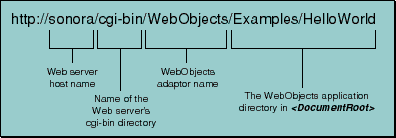 Table of Contents
Table of Contents  Previous Section
Previous Section
WebObjects Adaptors
An initial request to a WebObjects application consists of a URL like that shown in Figure 6.
Figure 6. URL to Access a WebObjects Application

Figure 7. The Role of a WebObjects Adaptor

 Table of Contents
Table of Contents  Next Section
Next Section